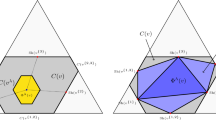Abstract
In the paper, we study a relation between command games proposed by Hu and Shapley and an influence model. We show that our framework of influence is more general than the framework of the command games. We define several influence functions which capture the command structure. These functions are compatible with the command games, in the sense that each commandable player for a coalition in the command game is a follower of the coalition under the command influence function. Some of the presented influence functions are equivalent to the command games, that is, they are compatible with the command games, and additionally each follower of a coalition under the command influence function is also a commandable player for that coalition in the command games. For some influence functions we define the equivalent command games. We show that not for all influence functions the compatible command games exist. Moreover, we propose a more general definition of the influence index and show that under some assumptions, some power indices, which can be used in the command games, coincide with some expressions of the weighted influence indices. Both the Shapley–Shubik index and the Banzhaf index are equal to a difference between the weighted influence indices under some influence functions, and the only difference between these two power indices lies in the weights for the influence indices. An example of the Confucian model of society is broadly examined.
Similar content being viewed by others
References
Albizuri MJ, Aurrekoetxea J (2006) Coalition configurations and the Banzhaf index. Soc Choice Welf 26: 571–596
Banzhaf J (1965) Weighted voting doesn’t work: a mathematical analysis. Rutgers Law Review 19: 317–343
Coleman JS (1971) Control of collectivities and the power of a collectivity to act. In: Lieberman B (eds) Social Choice. Gordon and Breach, New York, pp 269–300
Coleman JS (1986) Individual interests and collective action: selected essays. Cambridge University Press, Cambridge
Deegan J, Packel EW (1978) A new index of power for simple n-person games. Int J Game Theory 7: 113–123
Dubey P, Shapley LS (1979) Mathematical properties of the Banzhaf power index. Math Oper Res 4: 99–131
Felsenthal D, Machover M (1998) The measurement of voting power: theory and practice, problems and paradoxes. Edward Elgar, London
Grabisch M, Roubens M (1999) An axiomatic approach to the concept of interaction among players in cooperative games. Int J Game Theory 28: 547–565
Grabisch M, Rusinowska A (2008a) Measuring influence among players with an ordered set of possible actions. GATE Working Paper, 2008-01, GATE, Ecully, France
Grabisch M, Rusinowska A (2008b) A model of influence in a social network. Theory Decis (forthcoming)
Hoede C, Bakker R (1982) A theory of decisional power. J Math Sociol 8: 309–322
Holler MJ, Packel EW (1983) Power, luck and the right index. J Econ 43: 21–29
Hu X, Shapley LS (2003a) On authority distributions in organizations: controls. Games Econ Behav 45: 153–170
Hu X, Shapley LS (2003b) On authority distributions in organizations: equilibrium. Games Econ Behav 45: 132–152
Johnston RJ (1978) On the measurement of power: some reactions to Laver. Environ Plan A 10: 907–914
König T, Bräuninger T (1998) The inclusiveness of European decision rules. J Theor Polit 10: 125–142
Lindner I (2008) The power of a collectivity to act in weighted voting games with many small voters. Social Choice Welfare 30: 581–601
Owen G (1977) Values of games with a priori unions. In: Hein R, Moeschlin O (eds) Essays in mathematical economics and game theory. Springer, New York, pp 77–88
Owen G (1981) Modification of the Banzhaf–Coleman index for games with a priori unions. In: Holler MJ (eds) Power, voting, and voting power. Physica Verlag, Würzburg, pp 232–238
Penrose LS (1946) The elementary statistics of majority voting. J R Stat Soc 109: 53–57
Rae D (1969) Decision-rules and individual values in constitutional choice. Am Polit Sci Rev 63: 40–56
Shapley LS (1994) A Boolean model of organization authority based on the theory of simple games. Mimeo
Shapley LS, Shubik M (1954) A method for evaluating the distribution of power in a committee system. Am Polit Sci Rev 48: 787–792
Author information
Authors and Affiliations
Corresponding author
Additional information
The authors wish to gratefully thank two anonymous referees for useful suggestions concerning this paper.
Rights and permissions
About this article
Cite this article
Grabisch, M., Rusinowska, A. Measuring influence in command games. Soc Choice Welf 33, 177–209 (2009). https://doi.org/10.1007/s00355-008-0350-8
Received:
Accepted:
Published:
Issue Date:
DOI: https://doi.org/10.1007/s00355-008-0350-8




